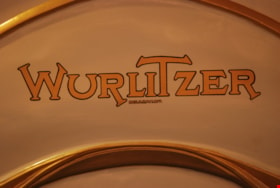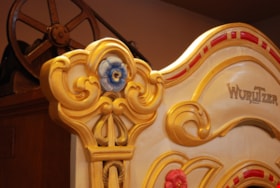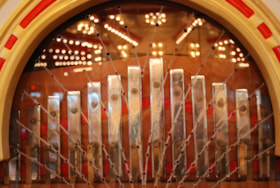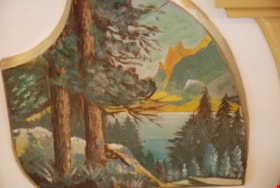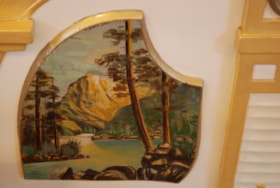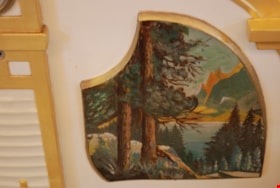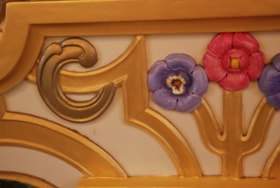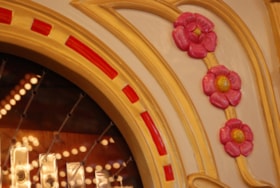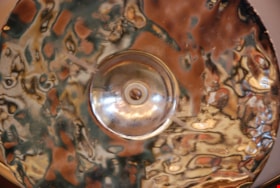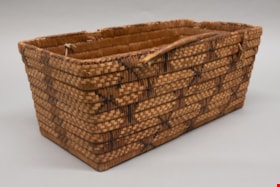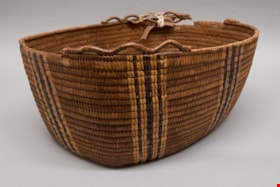Narrow Results By
Person / Organization
- British Columbia Ferry Services Incorporated 1
- British Columbia Provincial Police 1
- Burnaby Village Museum 2
- Canada Summer Games 1
- Century Park Museum Association 2
- C.W. Parker Company
- Girl Guides of Canada 2
- Henderson, Vivian 1
- Hill, Annie Sara Kenrick 2
- Hill, Louis Claude "Claude"
- Hurren, Anthony R. 1
- Lower Mainland Association of the Friends of the Vancouver Carousel 1
band organ
https://search.heritageburnaby.ca/link/museumartifact33964
- Repository
- Burnaby Village Museum
- Accession Code
- BV991.21.1
- Description
- This is a Wurlitzer Military Band Organ, Style 146B. Built by the Rudolph Wurlitzer Company, ca 1925. The organ is supposed to recreate the sound of a 20-piece military band, with percussion instruments that include bass drum, snare drums, cymbals, and xylophones, as well as pipes to reproduce the sounds of trumpets, trombones, flutes, and violins. This band organ is operated by paper rolls based on Wurlitzer's unique, 46 note roll scale, "Style 150". Our Model 146B has duplex roll frames, allowing continuous playing, one roll rewinds as the other is playing. An electric motor mounted on the top uses a belt to drive a crankshaft that powers both the air bellows that feed the various music pipes as well as the roll mechanism. The band organ was originally intended to be used with a carousel out of doors. A perferated sheet of plexie glass has been placed over the front opening to reduce the volume of the instrument inside the carousel building. Outside Visible Snare Drum on proper right Bass Drum with cymbal on proper left Inside 16 Octave Violin Pipes 3 Wooden Trombones 3 Octave Stopped Bass Pipes 15 Wooden Trumpets 15 Stopped Flute Pipes 16 Violin Pipes 9 Open Pipes Bottom 3 Open Bass Pipes 9 Stopped Accompaniment Pipes 16 Stopped Melody Pipes Bells 16 Bell Bars, playing form the musical roll.
- Object History
- The band organ was purchased and restored by the Friends of the Carousel to replace the original organ that had been sold before the carousel was acquired for the Burnaby Village Museum. The Friends of the Carousel bought this machine from a collector in Spokane, Washington. He had obtained it from a closed down travelling carnival company in Reno, Nevada. They had used it with a carousel in the American mid-west.
- Marks/Labels
- "Wurlitzer", painted in gold on front of organ
- Country Made
- United States of America
- Province Made
- New York
- Site/City Made
- North Tonawanda
Images
carrying basket
https://search.heritageburnaby.ca/link/museumartifact80210
- Repository
- Burnaby Village Museum
- Accession Code
- BV009.1.1
- Description
- Rectangular coiled cedar root basket with cedar slat foundation and walls that flare slightly towards rim. Decorated in beaded designs of cattail grass and black dyed cherry bark. Darker elements arranged in a butterfly design. Butterflies are said to represent everlasting life by Stó:lō and Nlaka’pamux basket makers. Overcast handles sewn to basket with leather ties. One has been repaired with string. Finished with a braided rim. Triangular shaped stitches attach base to walls of basket. Interior Salish: Stl’atl’imx?
- Object History
- Basket, ca. 1895-1910, from the collection of the L. Claude Hill family, who owned the property that became the Burnaby Village Museum. According to the Hill family, L. Claude's wife Anne Sarah Hill (nee Kendrick) traded blankets for baskets, although it is not known if this particular basket was obtained in this manner. Indigenous people travelled the trail that crossed Deer Lake Brook (Douglas Road / Canada Way).
- Measurements
- Measurements: width 24 cm and length 44 cm and depth 18 cm. All measured from top edge to outside.
- Country Made
- Canada
- Province Made
- British Columbia
- School/Style
- Coast Salish
- Culture
- Stl’atl’imx
Images
Documents
work basket
https://search.heritageburnaby.ca/link/museumartifact80211
- Repository
- Burnaby Village Museum
- Accession Code
- BV009.1.2
- Description
- Oval shaped coiled cedar root basket with cedar slat foundation. Overcast rim with remnants of a loopwork border. Decorated with vertical stripes of imbricated designs in canary grass and black dyed cherry bark. Cherry bark can be distinguished by the small eyes in the surface of the bark. If the basket maker is skilled the bark has a shiny appearance, if it has not been scraped properly it has a greyish tinge. Canary grass is differentiated from cattail and bear grass by its shiny appearance according to a Stó:lō/Stl’atl’imx elder and basket maker from Mount Currie, who was married into Upper Sḵwx̱wú7mesh.
- Object History
- Basket, ca. 1895-1910, from the collection of the L. Claude Hill family, who owned the property that became the Burnaby Village Museum. According to the Hill family, L. Claude's wife Anne Sarah Hill (nee Kendrick) traded blankets for baskets, although it is not known if this particular basket was obtained in this manner. Indigenous people travelled the trail that crossed Deer Lake Brook (Douglas Road / Canada Way).
- Measurements
- Measurements: width 31.5 cm and length 51.5 cm and depth 19.5 cm all measured from top edge to outside of basket, not including trim.
- Country Made
- Canada
- Province Made
- British Columbia
- School/Style
- Coast Salish
- Culture
- First Nations
